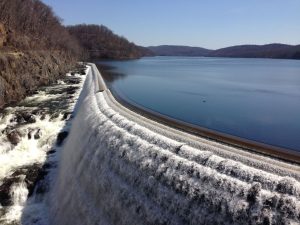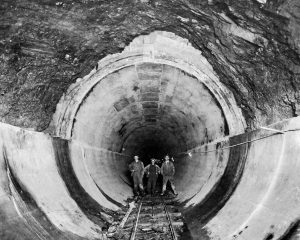
Water spills down the side of the New Croton Dam in Cortlandt, New York, which was built in 1907. Credit: Fifi + Hop.
By JACK DELANEY | jdelaney@queensledger.com
In 1997, a complex tangle of interests that included the EPA, Albany, the City Council, a coalition of upstate towns, and a group of environmental nonprofits came together to see if a special deal could be struck: could New York City avoid filtering its water?
The benefits were clear. Per the 1974 Safe Water Drinking Act, any city that relies on surface waters — basically, reservoirs fed by river streams and precipitation — is required to filter that supply before it reaches residents. But filtration is an expensive process, and that’s especially true when a water system is on the scale of New York City’s, with 1 billion gallons of water drawn daily from three watersheds, covering over 1,000 square miles, that are carried down to the five boroughs via 7,000 miles worth of delivery infrastructure.
So the obscure 1997 agreement, known as a Filtration Avoidance Determination (or FAD), was billed as a way for taxpayers to save billions of dollars. If the reservoirs could pass an array of stringent tests, the EPA would waive the requirement that they be filtered. And for 27 years, satisfied by the New York Department of Environmental Protection’s (DEP) efforts, it has done just that.
That job is getting much more difficult, as NYC confronts a mounting water crisis. The city is currently undergoing its first drought watch in 20 years, and officials plan to shut down one of its main aqueducts this winter, because a section of tunnel under the Hudson River is ‘massively leaking,’ as reported by NBC, and needs repairs. Separately, flooding continues to plague Southeast Queens, where historical disinvestment has left many households with no answers for overflowing groundwater. Facing a headache-inducing panoply of things to fix, experts are relying on the FAD to keep costs manageable.
But this arrangement is fragile. Only six watersheds in the U.S. have been granted FADs by the EPA, and in June of this year one of those cities, Portland, Oregon, lost it. It’s now embarking on a $2.1 billion project to filter out cryptosporidium, a parasite spread by animal feces, and to protect against the threat of wildfire ash mixing with chlorine.
To many, these concerns might seem remote. Aside from the red skies of last year’s downward-drifting Canadian smoke, which briefly gave New York City the dubious honor of having the worst air quality in the world, wildfires are less of an ever-present reality here, for now.
But at a City Council hearing last Wednesday, the head of the DEP, Rohit Aggarwala, acknowledged that New York’s reservoirs also contain significant levels of cryptosporidium. Luckily, current infrastructure already incorporates a UV treatment that ensures that the germs can’t reproduce, rendering them harmless to humans.
Yet the case of Portland “reinforces the fact that we have to be vigilant,” Aggarwala said, noting that the filtration system they were required to build “is less than 110th the size of the plant we would need,” which officials estimate could cost between $20 and $40 billion.
This is especially true, given NYC’s odd position among the handful of cities that are still holding onto a FAD. Unlike its peers, its watersheds are populated. Consider this: in 2023, the DEP paid $165 billion in local taxes on its upstate properties. It’s the second largest taxpayer in Westchester, and in many counties north of the city its payments prop up entire school systems. When engineers in Seattle want to renovate its water infrastructure, they don’t have to think about giving a parking lot to a nearby town as a concession. Yet that’s exactly what the DEP must do, as it balances the politics of local economic development with its mandate to keep water safe for roughly 10 million people.
The next negotiations over the FAD are slated for 2027, and the hearing served in part as a rehearsal of the many variables that could go wrong before then.
The department operates its own police force to patrol the watershed for illegal contamination, replete with an academy, a detective bureau, an emergency service unit, a canine unit, and an aviation unit. But it has struggled to fill its openings. One sticking point is that DEP officers are technically classified as civil service rather than law enforcement, for pension purposes. This means that they can’t retire until age 63, whereas peers in other bureaus can do so after 25 years of employment.

Workers pose on the tracks of the Rondout pressure tunnel in 1910, showing off its newly-set concrete lining. Credit: New York Public Library.
“We are constantly losing our officers to other forces, in large part because of this massive disparity in the pension,” Aggarwala explained. “We currently have nearly a 20% vacancy rate, despite doing everything we can to recruit and maintain these [employees.]”
Another existential threat? Ducks, geese, and gulls. As DEP Assistant Commissioner David Warne outlined, an area of special concern is Kensico Reservoir, where scat from wildlife threatens to recreate Portland’s disease-fueled bind.
The Westchester Airport poses another risk for pollution, as does runoff from the hundreds of local farms around the reservoirs. Councilmember James Gennaro, Chair of the Committee on Environmental Protection, Resiliency, and Waterfronts, also worried that state government might hypothetically pressure DEC to use these reservoirs for flood control, sacrificing their role as a water supply.
But ultimately, the obstacles for the FAD may be much grander, and more intractable, than staff shortages or errant animals. As climate change hastens the spread of disease and worsens flooding, whether the city can safeguard its money-saving deal with the EPA — at a moment when there’s an acute need for funds to overhaul the city’s aging water infrastructure — remains to be seen.


